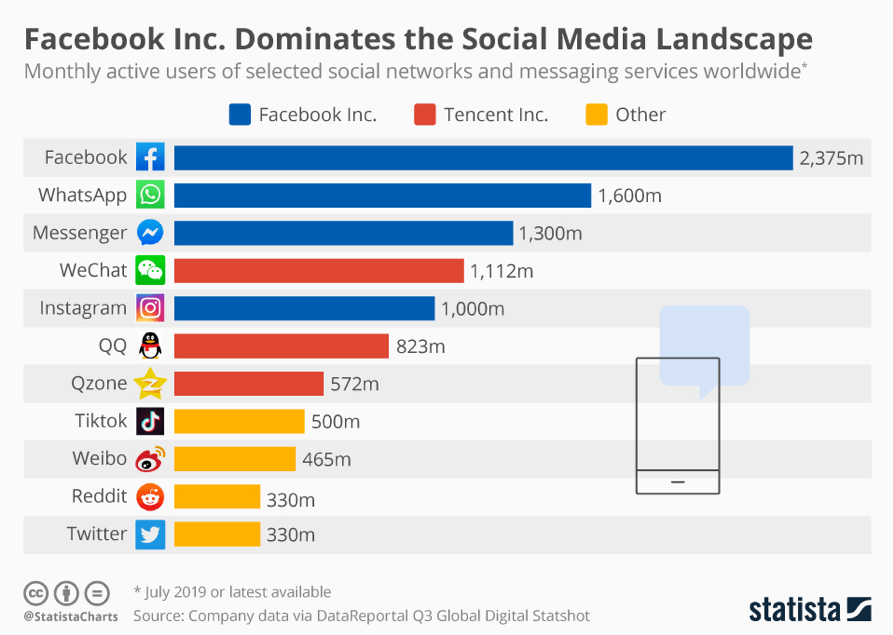Social commerce isn’t just a fashionable trend in the e-commerce world. It’s been around for a few years and gained traction as early as 2015. However, the COVID-19 pandemic almost two years ago brought it to the forefront. Since then, more organizations have embraced social commerce as a key component of their omnichannel commerce strategy and e-commerce arsenal.
In 2020, global revenues from social commerce platforms were approximately USD 220.2 billion.
By 2024, this figure is projected to reach USD 1.18 trillion, reflecting a substantial increase.
This growth underscores the expanding role of social media in e-commerce, with platforms increasingly facilitating direct transactions and influencing consumer purchasing behavior.
Looking ahead, the social commerce market is expected to continue its upward trajectory, with projections estimating a market size of USD 4.14 trillion by 2029.
Whether it’s Facebook, Instagram, or TikTok, everyone’s favourite social media sites have turned into lucrative sales channels for all social commerce businesses. Looking at the figures (figure below), we see that the e-commerce business is snowballing.
But what exactly is Social Commerce?
Defining Social Commerce
Social commerce is the purchasing and selling of goods or services directly within a social media platform. It increases the role of social media beyond its conventional application and encourages consumers to finish the entire purchase process without leaving their favourite apps.
According to The State of Social Media Investment Report, executives universally believe that social commerce is driving an increasing share of their company’s marketing-driven income. In addition, about eight out of ten people anticipate offering social media products or services within the next three years.

During the pandemic, Facebook, Instagram, and Pinterest announced redesigned social commerce features in 2020 to assist companies in streamlining online buying experiences. These capabilities enable the creation of new digital stores that can be discovered organically or through paid advertisement.
Social Commerce & E-commerce – Major Difference
E-Commerce refers to the process of buying and selling things over the internet. The model is practical but far from ideal. Let’s discuss how.
Mobile devices account for more than half of all internet traffic, and mobile users leave carts considerably higher than desktop users. As a result, streamlining your checkout experience is critical as shoppers shift to small screens for routine purchases.
So here, the concept of social commerce enters the picture. It eliminates the potential for abandoned transactions by eliminating drop-off places. Social commerce is the convergence of e-commerce and social media. It uses its social media networks for sales, resulting in a seamless in-app purchase path.
Reasons for new businesses to prefer social commerce
Are you unsure whether or not opening a social media shop is a good idea? Here are four compelling reasons to give social commerce a try.
1. Makes Shopping a social experience
Unlike a conventional eCommerce spree, shopping on social media is a far more participatory affair.
Before making purchases, consumers may consult with their friends, flaunt their new high-tops, read comments from other clever shampoo consumers, and interact directly with the kombucha companies they love.
Social commerce may be the next best thing for people who miss the social side of a day at the mall.
2. Higher e-sales
Numbers, like Shakira’ships, don’t lie. According to analysts, e-sales is expected to reach $735 billion in the next three years.
If you want to get in on the action, it’s a smart idea to take your products to the internet areas where your clients already congregate.
Shopping is a major priority for 48 per cent of Pinterest users, while 81 per cent of shoppers study products on Instagram and Facebook.
3. Hyper-targets your ideal clientele
With so much client data available on social media, you have a fantastic opportunity to fine-tune and focus your advertising.
Your horse-print bathrobes can be advertised directly to equestrians who enjoy flannel. Likewise, cool young dads may beam adorable baby-sized eyewear straight to their feeds.
Unlike traditional e-commerce and marketing, social commerce allows you to bring particular, ready-to-buy products in front of the specific people who would adore them.
4. Frictionless user experience
Look at it, click on it, and buy it. Social media stores make the consumer journey easier, which remove friction from discovery to purchase. They’ve arrived. The product is available. There’s nowhere else to go but the cash register.
Every mouse click is an opportunity for potential consumers to change their minds. If consumers have to click from your ad to your website, add the product to their cart, and then enter their credit card information, that’s a lot of time for them to lose interest.
Remove the processes that aren’t necessary and bring the shopping to you.
Social Commerce Industry Leaders: 7 Top Examples
The Tiny Tassel
Tiny Tassel’sexample of posting listings that other brands should follow expresses value. This practice instills confidence in potential purchasers unfamiliar with your brand, encouraging them to make their first purchase.
Other brands should emulate Tiny TTassel’sexample of posting listings that communicate value. This inspires new customers to make their first purchase by instilling trust in your e-commerce business.
Patagonia
Pinterest boards for Patagonia can be set up as product navigation tools for your audience. Take, for example, Patagonia’s Pinterest structure: their Product Pinboards are designed to look like the rand website navigation, giving returning visitors and new potential consumers a familiar experience when they visit the main site.
Most social commerce platforms allow you to recreate your brand’s experience with just enough flexibility. Make your audience experience consistent by using these technologies.
Facebook’svast reach is what propels it to the top of the list of marketing destinations for businesses. According to our first projection, Facebook will be the most popular social commerce network in the United States in 2021, with 56.1 million buyers.
To assist small and medium-sized companies (SMBs) in bringing their storefronts online during the pandemic, Facebook created Facebook Shops in 2020, a mobile platform where businesses may open online stores for free. If the idea succeeds, Facebook Shops could eventually expand to larger businesses.
Instagram, owned by Facebook, is a significant participant in the social commerce arena thanks to its influencer culture.
Instagram launched a checkout feature in 2019 to make it easier for brands to make purchases directly on the network. IInstagram’sshoppable content was taken a step further in 2020 when they added the purchase tab icon to the bottom of the homepage. Instagram users may now click on the emblem to see and purchase things sold by firms, influencers, and celebrities they follow.
Tik Tok
Even though TikTok is new to the social commerce industry, its Chinese heritage gives it an advantage over platform competitors because it has experience with what has worked and what hasn’t in other countries.
As it reaches product-market fit, TTikTok’salgorithmic power and engaged, tech-savvy user base have the potential to unleash fast growth. And, thanks to its new partnership with Walmart, it now has a formidable eCommerce partner to help it meet and exceed consumer demand.
Twitter is probably the least popular social site for social commerce, especially since it dropped its buy button feature in 2017. However, the platform allows marketers and businesses to engage in social listening, which might help with their social commerce strategy later.
Brands may evaluate that data and design a social media strategy based on it by gaining insight into exactly what their audience is talking about and being honest about what they like and don’t like.
Snapchat
Snapchat has public profiles now so you can create that social commerce experience for your consumers within the app. Snapchatters can subscribe to a brand and brands can link their Shopify store on their business profiles so their subscribers can browse, try on, and buy their favourite products right there.

Master Social Customer Care and Support
Manage your brand’s social presence by monitoring and managing incoming messages and comments across your social networks.
14 days free trial – no credit card requiredIs Social Commerce suitable for your niche?
According to Insider Intelligence, retail, social commerce sales in the United States will increase by 35.8% to $36.62 billion in 2021. While fashion categories like garments and accessories continue to be the most popular on social media, other lifestyle firms selling technology and home decor are also important. In addition, the social commerce ecosystem is best suited for brands with new and differentiated items.
Social Commerce Trends to Watch Out for in 2025
Users of social media spend a lot of time reading through their news feeds. Therefore, to achieve success, brands feel the urge to maintain an omnipresent demeanour on social media platforms.
Social commerce trends have established themselves as indisputable methods for the eCommerce business, and they will continue to do so in the years ahead.
When it comes to data, Instagram and Snapchat are leading the way in terms of generating purchases from Generation Z, as they spend 2x more time purchasing on social media than the typical consumer. Gen X, on the other hand, is a Facebook user.
The speed and ease of online purchasing have fueled tremendous development in eCommerce, which has been boosted by social isolation and stay-at-home orders during the coronavirus pandemic.
As of 2024, the average daily time spent on social media worldwide is approximately 143 minutes, reflecting a decrease from 151 minutes in 2023.
In the United States, adults are projected to spend about 1 hour and 50 minutes daily on social media by 2025.
- Brands are increasingly integrating social media checkout and shopping features to capitalize on this trend.
- The Social Commerce 2024 report by Insider Intelligence delves into the most important social commerce trends and techniques, offering valuable insights into this rapidly evolving landscape.
All of this has paved the way for following trends in the arena of social commerce:
1. Enhanced Discoverability Via Visual Shop Fronts On Instagram
Visual shopfronts can help you find what you’re looking for. Users on Instagram are attempting to convert their inspiration into purchases. According to Instagram data, 70% of shopping lovers use the platform to find new products.
The visual storefront on Instagram allows users to shop from photos and videos no matter where they are in the app. Brands can also curate products into themes using the platform’s customization features.
Furthermore, by identifying the products with their descriptions, discoverability is made simple. In the feed and articles, brands can bring attention to products from their catalogue. It allows users to learn more about the product. Instagram is transforming the way people shop by motivating them with eye-catching photos of products, how other people are using them, and customer reviews.
2. Shoppable Instagram Feeds On Your Website
Instagram is a popular social commerce trend that allows marketers to turn their Instagram feeds into shoppable stores.
Brands can now link the shoppable Instagram feed to their eCommerce websites or online storefronts to generate sales, traffic, and revenue thanks to systems like Taggbox Commerce.
Brands can compile their Instagram feeds and user-generated content (UGC) from hashtags into a feed, tag products to make the feed shoppable, and then publish the Instagram shoppable feed on their website homepage, category page, product page, or even create pages like “inspiration, “hop Our Instagram” or “hop The Look.”
3. Conversational Chatbots
The primary reason why connection platforms like Facebook and Whatsapp grew so rapidly was that social media encouraged discussions between people. By upgrading to AI capabilities via chatbots, organizations can now get a cost and sales advantage.
Chatbots eliminate the need for a human to respond to client inquiries. It can provide recommendations based on the clients’ choices, share product images, and request human assistance if necessary.
Users are more interested than ever in customized experiences. They are more likely to interact with brands that respond quickly and precisely, making the adoption of chatbots a trend to watch.
4. The increased role of micro-influencers
According to Instagram, the platform’s influencers influenced 87 per cent of people’s buying decisions.
Collaboration with influencers is always a good strategy for increasing your brand’s exposure, regardless of the industry you serve. Choose an influencer that specializes in your niche and has a large following.
Micro-influencers, in particular, have a higher percentage of audience engagement, and people pay attention to what they have to say. Influencers can help brands at every point of the consumer journey, from launching a new product to sharing reviews to generating sales by forming authentic, innovative, and cost-effective collaborations.
Even though this method is already popular, it should be kept in mind.
5. Smooth shopping experience
Providing the user with a smooth experience has become critical. The easier and faster it is to check out, the more likely you will make money by giving your users a better experience.
Allow customers to log out in one step by removing the “add to basket” option and allowing them to complete the transaction immediately. This also minimizes the likelihood of cart abandonment, which is a key worry for online businesses.
Furthermore, the fact that users’ attention spans have greatly decreased makes it even more critical for brands to develop a frictionless experience for users to get more confidence and sales.
6. Increase in commercial integration on social media
Instagram Shopping, Facebook Shops, and Pinterest Buyable Pins have all updated their features to keep up with the latest social commerce trends. Snapchat, with 229 million users, is another platform that is attempting to introduce social commerce trends to its consumers to stay ahead of its competitors
7. Customized Facebook Shops
Using Facebook for business is now a necessity. As a result, there’s a good possibility you’ve already used the platform to upsell, which means transitioning to Facebook shops could be the next logical step in your sales process.
One of the most appealing aspects of Facebook shops is that they are fully customizable. Also, help you by allowing you to create a customer experience that is consistent with your brand.
Make any necessary changes to the fonts, colours, and images. You may also easily transfer your website’s product catalogue into the Facebook shop.
Furthermore, connecting to the platform is simple and effective. Facebook shops enable businesses to engage with customers on other Facebook platforms such as Instagram, Whatsapp, and Facebook Messenger.

Analyze, Understand, and Improve Your Social Strategy
Stack your key social metrics against those of your competitors and make targeted steps towards social media success.
14 days free trial – no credit card requiredSocial Commerce Hacks Every Entrepreneur Can Follow
Professionals indulging in social commerce produce and distribute messaging and interactive features to boost online sales and other e-commerce efforts.
Following are some of the marketing strategies used for social commerce:
-
-
-
- Users are invited to vote on product style or options.
- Providing customized buyer options
- Using huge, eye-catching graphics to entice viewers to click.
- Using movies to demonstrate the product in action and from various perspectives
- User-submitted photos, comments, and feedback are encouraged.
- Using celebrity endorsements to help sell the goods
- Directly linking to a checkout or shopping cart
- Offering discounts or freebies to users who post the goods on their social media feeds
-
-
Social commerce promotes a social buying platform where customers and sellers can debate and compare notes on their online shopping experiences.
Economical Products – A Must-Follow Trend in Social Commerce
People use social media sites mostly to keep up with the latest updates from their friends and family, keep up with current trends, find inspiration, or simply scroll and be delighted by the different content. However, they are rarely there to make complete purchases.
Having a distracted state of mind makes it even more difficult to retain their attention. Prioritize displaying low-cost products that have performed successfully to overcome this problem.
Furthermore, social commerce is still a very new notion. Buyers are hesitant to purchase anything pricey, thus focusing on low-cost things has been popular.
The Verdict – Social Commerce Trends in 2025
This year, the tremendous rise of e-commerce will provide additional opportunities for marketers to create social commerce experiences as social media continues to change. Brands can use social commerce to build seamless buying experiences and reach customers where they are. Marketers must, however, have a clear plan and use the appropriate channels to interact with their target audience to thrive in social commerce.
Established networks like Facebook and Instagram are ideal places to start if you’re new to social commerce. Brands wishing to take the next step should experiment with new technologies, such as chatbots, to save time and money and increase consumer confidence.






Comments
One response to “A Complete Guide On Social Commerce for 2025”
This is a very educative and informative article to guide social media users,newbies and of course would be user of the huge benefit of social media marketing platforms.